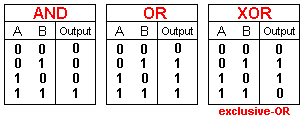and
Clever Commands
P13
Everyone wants to advance to the "Nth degree" and
rise to the top of his chosen field.
In programming, it's producing a program or routine using the least number of
instructions or applying the most-complex reasoning to a sequence.
This has some advantages and drawbacks.
The advantage is the pride you get out of creating a feature that requires
thought and interpretation. The down-side is trying to work out what the
instructions are achieving, when you have to re-work the program at a later
date.
Advanced Programming quite often uses uses instructions called LOGIC COMMANDS to produce
powerful outcomes.
To show the power of LOGIC COMMANDS we will SWAP THE CONTENTS OF
W with a FILE, without Logic Commands:
Example: File 0C = A5h
File W = C3h
File 0D = temp storage
File 0E = temp storage
|
With LOGIC COMMANDS it takes 3 instructions to swap the contents of W with a file.
|
When using LOGIC COMMANDS you have to know the outcome of each instruction and the only way to see what has happened is to look at it "bit-by-bit."
To understand LOGIC operations we need the TRUTH TABLE for 3 terms:

The OR Truth Table applies to IORLW 00h, IORWF 0C,0 IORWF 0C,1 instructions
The XOR Truth Table applies to XORLW 00h, XORWF 0C,0 XORWF 0C,1 instructions
OR and IOR means Inclusive-OR. They are both the same. The "I" reinforces the fact that the outcome includes the debate when the two outputs are HIGH. To remove the "debate," the XOR command is provided. It specifically states that only one input can be active for the result to be logic 1.
For the operation above, the bit-changes after each instruction are as follows:
Start values:
W = 1010 0101 = A5h
0C = 1100 0011 = C3h
After 1st instruction:
W = 1010 0101 = A5h
0C = 0110 0110 = 66h
After 2nd instruction:
W = 1100 0011 = C3h
0C = 0110 0110 = 66h
After 3rd instruction:
W = 1100 0011 = C3h
0C = 1010 0101 = A5h
You
can see an enormous understanding of the outcome of an operation is needed, to predict the result of two or three
consecutive logic operations.
That's what we mean by Advanced Programming.
Indirect Addressing
The animation below shows how the information passes to the files:
The following instructions read files 21h, 22h, 23h, 24h, 25h,
26h, 27h and 28h and output to port B (file 06).
Here is a very clever routine to change the value of a file without making
the change obvious.
Lots of other clever instructions
and routines are too advanced for this course and fortunately, will not be needed.
Routines for debouncing 8 switches with a matrix program, multiplying by 24 or finding
the square root of a number, can be found on the PIC Webring.
This is a very good ring for the PICmicro chip but as with everything
on the web, you have to spend a lot of time searching through the enormous
amount of material to find what you want.
Another clever logic instruction tests two bits to see if they are both HIGH.
This is the same as COMPARE.
For instance, you may have two inputs and need to know when both are HIGH.
The input lines are RA0 and RA2.
MOVLW
05 XORWF 05,0
BTFSS 03,2
GOTO 1
GOTO 2
;0000
0101
;Test Z flag
;both inputs are NOT HIGH
;both inputs are HIGH
Values:
W = 0000 0101 = 05h
Input Port 05 = 0000 0101 = 05h
W is loaded with a value equal to
the bits being tested. The XOR function compares the same bit in each file and
if they match, the answer is 0. If the final of all 8 matches is zero, the
zero flag is "raised" (SET). Look at the zero flag in the STATUS
register (file 03, bit 2) and if it is SET, the micro advances to GOTO 2 in
the program.
Sometimes you may need to introduce instructions to make the understanding of
a program enormously difficult - to foil "pirates."
Here is a clever item that takes considerable understanding to see
what it does.
To clear a file:
MOVLW 00 ANDWF 0C,1
;File
0C = 0101 1100 or any value
;W = 0000 0000
;AND W with 0C. File 0C will have 000 0000
One of the powerful features of the PIC chip is to be able to address a number
of files in a block.
Data can be written into or read from the files via a loop program in which a
file (called FSR) is incremented to read down the block (the read/write file
is called INDF).
These two special files allow a sub-routine to be created to look at the
block.
They are: INDF and FSR
INDF is a special file called INDirect File. It has
the address 00.
FSR is a special file called File Select Register. It has
the address 04. It is not like the other files in the micro but a POINTER
FILE and is used in conjunction with INDF.
The INDF file is not a real file either. It is like a Robot Arm. It reaches down the
list of files and picks up the contents or delivers the contents of a file to
the program. The file it reaches is determined by the value in FSR.
FSR is loaded with the address of the file you wish to read/write.
By loading FSR with a value, you can reach a
file and by incrementing FSR, you can reach the next file etc.
If you load a value into INDF, you will actually load the value into the file
pointed to by FSR.
If you read INDF, you will actually read the contents of the file pointed to by
FSR.
This is called INDIRECT ADDRESSING.
This arrangement has an advantage.
You can consecutively read 8, 10 or 20 files or clear 20 files or load into 20
or more files with a simple looping sub-routine. It's a very powerful
feature.
The following instructions show exactly how FSR and INDF work. A value of 8Fh is
put into into file 21h. This does not show the power of the two instructions. It
just shows how they work.
MOVLW
21h
MOVWF 04
MOVLW 8Fh
MOVWF 00
;Load
W with the address of file 21h
;Load 21h into FSR
;Put 8F into W
;Put 8Fh into file 21h

The following instructions put a value of 8Fh into files 21h, 22h, 23h,
24h, 25h, 26h, 27h and 28h.
Loop1
MOVLW
08
MOVWF 20h
MOVLW 21h
MOVWF 04
MOVLW 8Fh
MOVWF 00
INCF 04
DECFSZ 20h
GOTO Loop1
RETURN
;8
loops of the program
;File 20h is the decrementing file
;Load
W with start of 8 files
;Load 21h into FSR
;Put 8F into W
;Put 8Fh into file 21h
;Increment FSR to make INDF go to next file
Loop1
MOVLW
08
MOVWF 20h
MOVLW 21h
MOVWF 04
MOVF 00,0
MOVWF 06
CALL Delay
INCF 04
DECFSZ 20h
GOTO Loop1
RETURN
;8
loops of the program
;File 20h is the decrementing file
;Load
W with start of 8 files
;Load 21h into FSR
;Copy file 21h (or next file) into W
;Move W to output Port B
;Show value on 7-segment display etc
;Increment FSR to make INDF go to next file
The secret lies in the fact that when a file is rotated, the end bit moves
into the CARRY, and the bit in the carry enters the other end of the file. If
you don't want an unknown value from the carry to enter a file, the CARRY must
be cleared before a RRF or RLF operation. (BCF 03,0)
When a file is rotated left (or right) and another file is then rotated left
(or right) the end bit of the first file is transferred to the second file -
via the CARRY!
With an 8-loop program, the two files will be swapped!
Loop1
MOVLW
08
MOVWF 20h
BCF 03,0
RRF 1A,1
RRF 1B,1
DECFSZ 20h
GOTO Loop1
RRF 1A,1
RETURN
;8
loops of the program
;File 20h is the decrementing file
;Clear the carry before starting
;Rotate file 1A right
;Rotate file 1B right
;Loop
;Put the last bit from file 1B into 1A
Almost every requirement for a program can be performed with a number of very
simple steps, involving instructions in the list:
PIC16F84
Instructions.